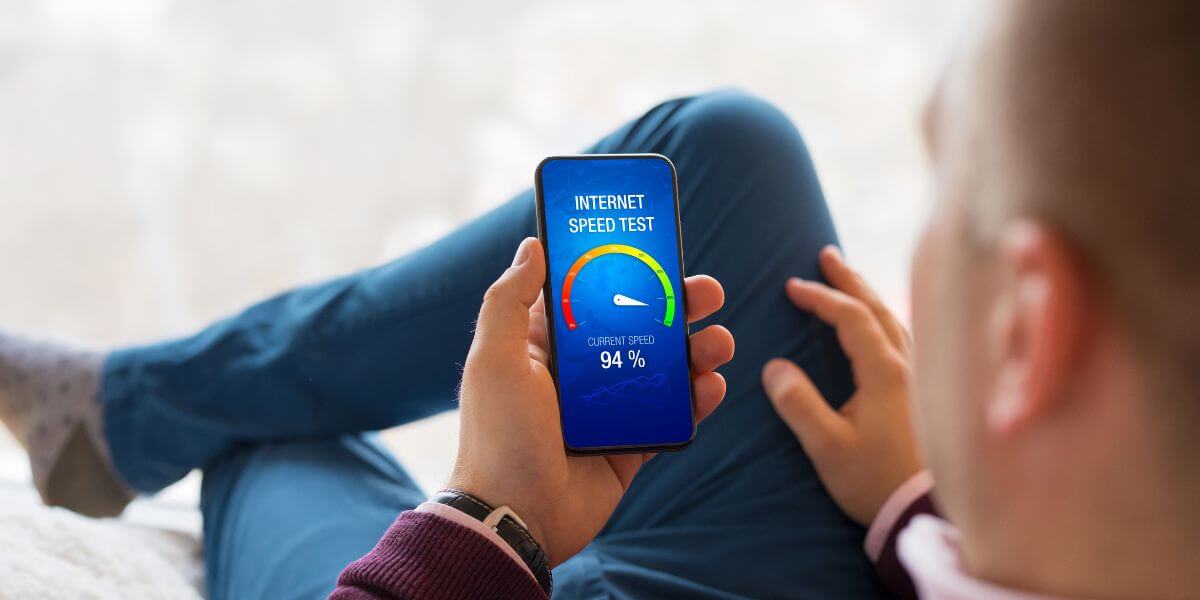How Can I Test My Internet Speed?
Table of Contents
Fast internet isn’t just a luxury anymore—it’s a must-have. Whether you’re working from home, streaming shows, or video chatting with family, knowing your actual internet speed is key to making sure you’re getting the performance you need. Learning how to test your internet speed—and understanding what those results mean—can help you troubleshoot issues and make smarter decisions about your service.
What Is an Internet Speed Test?
An internet speed test is basically a tool that checks how fast and reliable your connection is. When you run a speed test, it looks at three main things:
- Download speed: How fast your internet can pull data to your device (like streaming a movie).
- Upload speed: How fast you can send data out (like sending emails or uploading files).
- Latency or ping: The time it takes for data to go back and forth (think of it as how quickly a webpage starts loading) [1].
Imagine your internet connection as a two-way street. Download speed is the traffic flowing toward your house, and upload speed is the traffic heading out. The wider the street, the more cars—or, in this case, data—can travel at once. Latency, on the other hand, is like the time it takes for a car to drive from one end of the street to the other.
How to Run an Internet Speed Test

Prepare for your speed test
Running a speed test is super simple, but there are a few steps to get the most accurate results. Many internet providers offer their own tests, but you can also try sites like Speedtest.net [2], Fast.com [3], or Google’s speed test [4].
Before testing, make sure to:
- Use an ethernet cable to connect directly to your router for the best results.
- Close apps, browser tabs, and pause downloads or streaming.
- Ensure other devices aren’t hogging your network.
For a more accurate picture of your internet speed, try running tests at different times of day. Speeds can vary depending on how busy the network is, so testing during both peak and off-peak hours will give you a better idea of your connection’s overall performance.
Understanding Your Speed Test Results
Once the test finishes, you’ll see a few key numbers that measure your connection:
- Download speed (Mbps): This is typically the biggest number. Basic browsing or emails only need 1-5 Mbps, but streaming 4K videos can require 25 Mbps or more. For households with multiple users or devices, speeds of 100 Mbps or higher are ideal.
- Upload speed (Mbps): Usually smaller than download speeds, but still important—especially for video calls, cloud backups, or live streaming. Video calls need at least 1-2 Mbps, but 10 Mbps or more is better for bigger tasks like uploading large files.
- Latency (ms): Measured in milliseconds, this is how fast data travels between your device and the internet. Lower is better—under 20ms is excellent. Latency over 100ms can cause delays in online gaming or video calls.
Understanding what these speed test results mean [5] can help you figure out if your internet is meeting your needs or if it’s time for an upgrade.
Factors That Can Affect Speed Test Results

What your speed means
Your speed test results can be influenced by more than just your internet plan. For starters, the devices you use matter—a lot. Older devices might struggle with faster speeds because of outdated network cards, slower processors, or older Wi-Fi tech. Network congestion is another factor. Your speeds can fluctuate depending on the time of day and how many people in your area are online.
The distance between you and the test server also plays a role. Generally, the closer the test server is, the more accurate your results will be. That’s why your ISP’s speed test tool often gives the most accurate numbers—it connects you to nearby servers on their network.
What to Do If Your Speeds Are Slower Than Expected
If your speed test results aren’t matching what your plan advertises, don’t panic—there are some easy ways to troubleshoot. Start by double-checking your plan details. Remember, the speeds advertised are usually “up to" a certain number, not a guaranteed baseline.
Next, take a look at your equipment. Make sure your modem and router can handle your plan’s speeds and that all cables are securely connected. Simple tweaks to your setup can also make a big difference. Place your router in a central spot, avoid interference from walls or other electronics, and double-check that you’re using up-to-date Wi-Fi security settings.
If you’ve tried all this and your speeds are still lagging, it’s time to give your internet provider a call.
The Importance of Regular Speed Testing

Test your speeds regularly
Running regular speed tests is a great way to keep tabs on your connection and make sure your internet is working properly. Test at different times of the day, on different devices, and with both Wi-Fi and wired setups. Doing this gives you a clear picture of how your connection performs.
Speed tests are also handy when making changes to your network or troubleshooting issues. If you’re tweaking your setup, running a test afterward can confirm if your changes actually improved things. And during connectivity problems, testing can help pinpoint whether the issue is with your equipment, your service, or a specific device or app.
Getting the Fastest Internet for Your Needs
If your speed tests consistently show that your current internet plan isn’t cutting it, it might be time for an upgrade. Fiber internet, like Metronet’s service, is a great option. It offers advantages like symmetrical upload and download speeds, low latency, and more reliable connections. Basically, it’s built for today’s digital lifestyle.
Understanding and regularly testing your internet speed helps you stay in control of your connection. Speed tests give you a snapshot of your internet performance, but for the best insights, it’s worth running multiple tests over time and under different conditions.
By knowing your speeds and how to interpret the results, you can make sure your internet keeps up with your needs—whether you’re streaming shows, gaming online, or relying on a fast connection for work. Staying informed helps you make smarter decisions about your service and ensures you’re getting the connection you deserve.
Sources:
[1] Reddit. Are ping & latency the same thing?
[2] Speedtest. Speedtest by Ookla.
[3] Fast.com. Internet speedtest.
